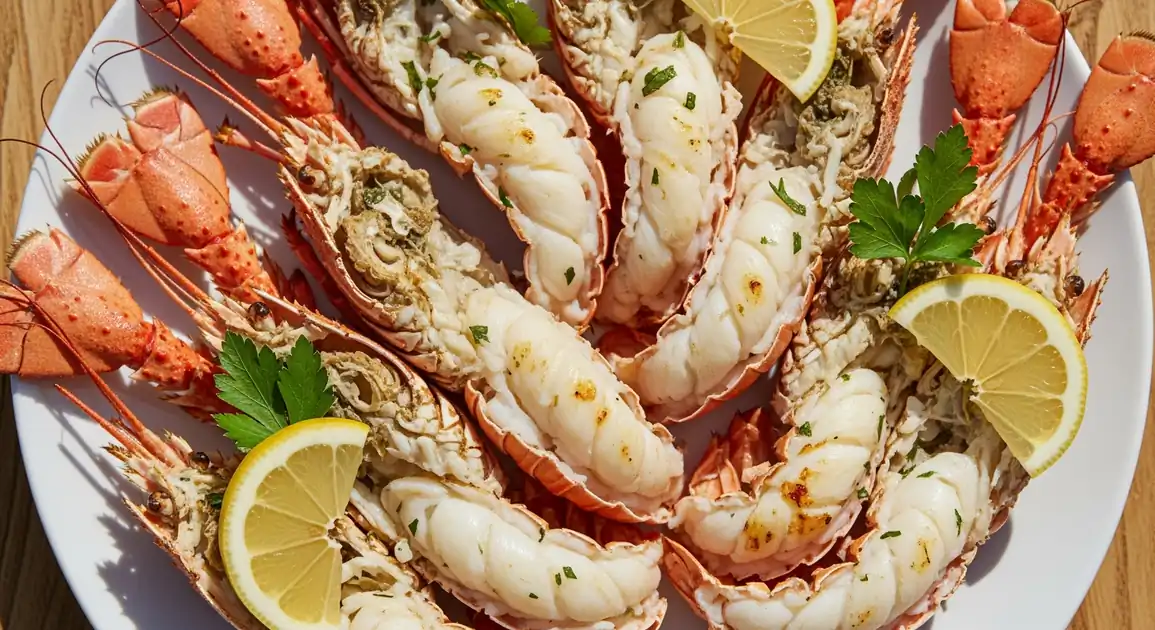Balmain Bugs
Balmain Bug

Description
Balmain Bugs are a sought-after seafood found primarily along the southern and eastern coasts of Australia. They feature prominently on menus in coastal cities and are available at major fish markets. Preparation styles vary, but simple methods showcasing the sweet flesh are most common.
Dietary Information
Serving information
Serving style
In restaurants: Typically served split lengthwise, grilled or steamed, often with lemon, butter sauce, salad, or fries. At markets: Sold whole (raw/green) or sometimes cooked.
Quick facts
Fish Markets: Early morning (e.g., 7 AM) to mid-afternoon. Restaurants: Lunch (12 PM - 3 PM), Dinner (6 PM - 10 PM).
Safety Tips
What to Look For
-
Fresh ocean or sea-salt smell
Absence of ammonia, sour, or overly fishy odors indicates freshness. It should smell clean like the sea.
-
Bright, intact shell
Shells should have good color (typically reddish-brown/orange) and not be cracked or damaged excessively.
-
Firm flesh texture (raw or cooked)
Raw flesh should be slightly translucent and firm. Cooked flesh should be opaque white and firm, not mushy or falling apart.
-
Clear eyes (if visible)
Eyes should look clear and full, not sunken or cloudy.
-
Reputable vendor with proper storage
Ensure the bugs are stored well-chilled on ice at fish markets or handled hygienically in restaurants.
-
Thoroughly cooked flesh (opaque white)
Crucial for safety. Ensure no part of the flesh remains translucent or raw-looking.
What to avoid
-
Strong ammonia or 'off' smell
This is a clear sign of spoilage and the bug should not be purchased or consumed.
-
Dull, discolored, or damaged shells
May indicate the bug is old or has been handled poorly.
-
Soft, mushy, or slimy flesh
Indicates poor quality or spoilage. Fresh bug flesh should be firm.
-
Bugs stored improperly (not iced/chilled)
Increases the risk of bacterial growth and spoilage.
-
Undercooked bugs (translucent flesh)
Consuming undercooked shellfish poses a significant health risk.
Price information
Price range
Budget tips
- Buying whole, raw bugs from fish markets is usually cheaper than restaurant prices.
- Prices per kilogram can fluctuate significantly based on season and catch size.
- Look for specials at seafood markets or restaurants, especially outside peak tourist season.
Value indicators
- Firm flesh, bright shell when raw.
- Sweet, clean flavor when cooked.
- Good size-to-price ratio (tail meat yield).
- Sourced from reputable suppliers known for freshness.
Where to Find This Dish
Major Fish Markets
Best place to buy fresh, raw bugs (e.g., Sydney Fish Market, Melbourne's Queen Victoria Market seafood hall). Some offer on-site cooking.
Sydney Fish Market, Queen Victoria Market
Morning (for freshest catch)
Seafood Restaurants
Widely available in restaurants specializing in seafood, particularly along coastlines.
Coastal towns, City harbourside restaurants
Lunch, Dinner
High-End Supermarkets/Grocers
May stock fresh or frozen bugs at their seafood counters.
Specialty food stores, Supermarkets with large seafood sections
Daytime shopping hours
Vendor Tips
- Ask the fishmonger when the bugs arrived and where they were caught for freshness insights.
- Compare prices per kilogram between vendors at markets.
- In restaurants, ask about the preparation method if not specified on the menu.
How to Order
Regional Variations
-
Grilled Balmain Bugs with Garlic Butter
(Grilled Balmain Bugs with Garlic Butter)
Split bugs grilled and basted with melted garlic butter, often finished with parsley and lemon.
-
Steamed Balmain Bugs with Ginger and Shallots
(Steamed Balmain Bugs with Ginger and Shallots)
A simple preparation highlighting the natural sweetness, steamed with aromatic ginger and spring onions (shallots).
-
BBQ Balmain Bugs
(BBQ Balmain Bugs)
Cooked on a barbecue, often with a simple marinade or glaze, imparting a slight smoky flavor.
-
Balmain Bug Mornay
(Balmain Bug Mornay)
A richer, classic preparation where the cooked bug meat is topped with a creamy cheese sauce (Mornay) and gratinated.
-
Balmain Bugs in Pasta or Risotto
(Balmain Bugs in Pasta or Risotto)
Cooked bug meat incorporated into pasta dishes (like linguine) or creamy risottos, often with white wine, garlic, and herbs.
Cultural context
History
Named after Balmain, a harbourside suburb of Sydney, New South Wales, where they were reportedly abundant in the past. While less common in Balmain itself now, the name persists. They have become a recognized feature of Australian seafood offerings, celebrated in restaurants and seafood markets across the country, especially in NSW and Queensland.
Local significance
Considered a premium Australian seafood delicacy, enjoyed by locals and tourists alike. Represents the quality of local seafood.
Eating customs
- Eaten with fingers or seafood forks to extract the tail meat.
- Lemon juice is almost always served alongside to squeeze over the meat.
- Discarded shells are usually placed in a separate bowl.